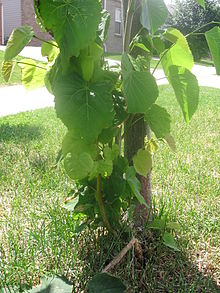Basal shoot

Basal shoots, root sprouts, adventitious shoots, and suckers are words for various kinds of shoots that grow from
In botany and ecology

In
This is a phenomenon of natural "
The root sprout is a form of dispersal vector that allows plants to spread to habitats that favor their survival and growth. Some species, such as poplars and blackthorn, produce root sprouts that can spread rapidly, and they can form thick mats of roots that can reclaim areas that have been cleared of vegetation by logging, erosion, pasturing. The giant aspen, "Pando" is a dramatic example. These plants could be considered invasive, but they are cultivated or permitted to grow to stabilize soils and even to then be naturally replaced by non-pioneer species in locations as such those that have been developed for public works and along channels of waterways that may flood and reservoirs. These plants form shaded areas wherein new species may grow and gradually replace them.[citation needed]
In horticulture
Root sprouts and basal shoots can be used to propagate woody plants. Root sprouts can be dug or severed with some of the roots still attached. As for basal shoots, stool beds involve cutting a juvenile plant proximate to the surface of the soil and heaping soil over the cut so that basal shoots will form adventitious roots and later can be severed to form multiple, rooted, new plants. The technique is used especially for vegetative propagation of rootstocks for apple trees.[4]
References
- ^ ISBN 978-1-84246-604-9.
- ^ a b Hickey, M.; King, C. (2001). The Cambridge Illustrated Glossary of Botanical Terms. Cambridge University Press.
- ^ "Stolon". Dictionary.com. Archived from the original on 9 June 2007. Retrieved 7 May 2007.
- ^ A. N. Roberts W. M. Mellenthin (1957), Propagating Clonal Rootstocks (PDF), vol. Circular of Information 578, Agricultural Experiment Station Oregon State College Corvallis
